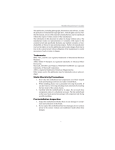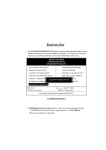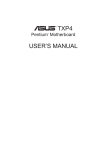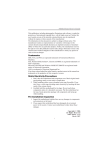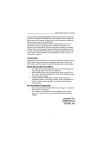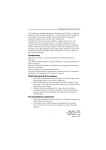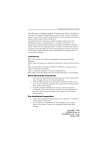Download PC CHIPS A33G motherboard
Transcript
Motherboard User’s Guide This publication, including photographs, illustrations and software, is under the protection of international copyright laws, with all rights reserved. Neither this guide, nor any of the material contained herein, may be reproduced without the express written consent of the manufacturer. The information in this document is subject to change without notice. The manufacturer makes no representations or warranties with respect to the contents hereof and specifically disclaims any implied warranties of merchantability or fitness for any particular purpose. Further, the manufacturer reserves the right to revise this publication and to make changes from time to time in the content hereof without obligation of the manufacturer to notify any person of such revision or changes. Trademarks IBM, VGA, and PS/2 are registered trademarks of International Business Machines. AMD, Sempron, Athlon 64/Athlon 64 X2 Dual-core/Athlon 64 FX are registered trademarks of Advanced Micro Devices Inc. Microsoft, MS-DOS and Windows 2000/XP are registered trademarks of Microsoft Corporation. AMI is a registered trademark of American Megatrends Inc. Other names used in this publication may be trademarks and are acknowledged. Static Electricity Precautions 1. Don’t take this motherboard and components out of their original staticproof package until you are ready to install them. 2. While installing, please wear a grounded wrist strap if possible. If you don’t have a wrist strap, discharge static electricity by touching the bare metal of the system chassis. 3. Carefully hold this motherboard by its edges. Do not touch those components unless it is absolutely necessary. Put this motherboard on the top of static-protection package with component side facing up while installing. Pre-Installation Inspection 1. Inspect this motherboard whether there are any damages to components and connectors on the board. 2. If you suspect this motherboard has been damaged, do not connect power to the system. Contact your motherboard vendor about those damages. Copyright © 2006 All Rights Reserved A33G Series, V1.0 May 2006 i Motherboard User’s Guide Table of Contents Trademark ............................................................................................................ i Chapter 1: Introduction ..................................................................................... 1 Key Features .................................................................................................................... 1 Package Contents ........................................................................................................... 4 Chapter 2: Motherboard Installation .............................................................. 5 Motherboard Components ............................................................................................ 6 I/O Ports .......................................................................................................................... 7 Installing the Processor ................................................................................................. 7 Installing Memory Modules .......................................................................................... 8 Jumper Settings ............................................................................................................ 1 0 Install the Motherboard ............................................................................................... 1 0 Connecting Optional Devices ..................................................................................... 1 2 Install Other Devices .................................................................................................... 1 4 Expansion Slots ............................................................................................................ 1 6 Chapter 3: BIOS Setup Utility ....................................................................... 18 Introduction .................................................................................................................. 1 8 Running the Setup Utility ................................................... …………………………...18 Standard CMOS Setup Page ....................................................................................... 1 9 Advanced Setup Page .................................................................................................. 2 0 Features Setup Page .................................................................................................... 2 1 Power Management Setup Page ................................................................................ 2 3 PCI/Plug and Play Setup Page .................................................................................. 2 4 BIOS Security Features Setup Page ........................................................................... 2 5 CPU PnP Setup Page .................................................................................................. 2 5 Hardware Monitor Page .............................................................................................. 2 6 Load Best Performance Settings ................................................................................. 2 7 Load Optimal Defaults ................................................................................................ 2 7 Save Changes and Exit ................................................................................................ 2 7 Discard Changes and Exit ........................................................................................... 2 7 Chapter 4: Software & Applications .............................................................. 28 Introduction .................................................................................................................. 2 8 Installing Support Software ........................................................................................ 2 8 Bundled Software Installation .................................................................................... 3 0 ii Motherboard User’s Guide Notice: 1. Owing to Microsoft’s certifying schedule is various to every supplier, we might have some drivers not certified yet by Microsoft. Therefore, it might happen under Windows XP that a dialogue box (shown as below) pops out warning you this software has not passed Windows Logo testing to verify its compatibility with Windows XP. Please rest assured that our RD department has already tested and verified these drivers. Just click the “Continue Anyway” button and go ahead the installation. 2. USB 2.0 Driver Limitations: 2-1. The USB 2.0 driver only supports Windows XP and Windows 2000. 2-2. If you connect a USB 2.0 hub to the root hub, plugging USB devices into this hub, the system might not successfully execute certain USB devices’ connection because it could not recognize these devices. Currently, we are working on such limitations’ solution. As soon as the olution is done, the updated USB drive will be released to our website: www.pcchips.com for your downloading. iii Motherboard User’s Guide Chapter 1 Introduction This motherboard has a Socket-AM2 supporting the newest and advanced AMD Sempron/Athlon 64/Athlon 64 X2 Dual-Core/Athlon 64 FX with HyperTransport Technology processors and Front-Side Bus (FSB) speeds up to1000 MHz. It integrates the SiS761GX Northbridge and SiS965L Southbridge that supports the built-in USB 2.0 providing higher bandwidth, implementing Universal Serial Bus Specification Revision 2.0. It supports AC’ 97 Audio Codec and provides Ultra DMA 133/100/66 function. It has one PCI Express x16, one PCI Express x1, one CNR and two 32-bit PCI slots. There is a full set of I/O ports including two PS/2 ports for mouse and keyboard, one serial port, one parallel port, one LAN port(optional), one VGA port, three audio jacks for Line-in, Line-out and Microphone, four back-panel USB2.0 ports and onboard USB headers providing extra ports by connecting the Extended USB Module to the motherboard. This motherboard is a Micro ATX size motherboard and has power connectors for an ATX power supply. Key Features The key features of this motherboard include: Socket-AM2 Processor Support • Supports AMD Sempron/Athlon 64/Athlon 64 X2 Dual-Core/Athlon 64 FX processors • Supports Front-Side Bus 1000 MHz Note: HyperTransport Technology is a point-to-point link between two devices, it enables integrated circuits to exchange information at much higher speeds than currently available interconnect technologies. Chipset There are SiS761GX Northbridge and SiS965L Southbridge in this chipset in accordance with an innovative and scalable architecture with proven reliability and performance. • High Performance Host Interface: -Supports AMD Athlon 64, Athlon 64 FX, Sempron CPUs −HyperTransport compliant bus driver with auto compensation capability • Integrated Host-to-PCI Express Bridge: −4 GB/s bandwidth for each direction −Compliant with PCI Express SPEC 1.0a • High Performance & High Quality 3D Graphics Accelerator: −Built-in 32-bit floating point format VLIM triangle setup engine −Built-in 2 pixel rendering pipelines and 4 texture units 1 Motherboard User’s Guide • • • PCI 2.3 Specification Compliance Integrated Multithreaded I/O Link Mastering Multithread I/O Link Mastering with Read/Write Concurrent and Read/ Read Pipeline Transaction Memory Support • Two 240-pin DIMM sockets for DDR SDRAM memory modules • Supports DDR2 800/667/533/400 memory bus • Maximum installed memory is 16 GB Expansion Slots • One PCI Express x1 slot • One PCI Express x16 slot • Two 32-bit PCI slots for PCI 2.3 compliant bus interface • One optional CNR slot Onboard IDE channels • Two IDE Connectors • Supports PIO (Programmable Input/Output) and DMA (Direct Memory Access) modes • Supports IDE Ultra DMA bus mastering with transfer rates of 133/100/ 66 MB/sec Serial ATA • Two Serial ATA Connectors • Transfer rate exceeding best ATA (~1.5 Gb/s) with scalability to higher rates • Low pin count for both host and devices AC’97 Codec • Compliant with the AC’97 v2.3 CODEC • Supports 6-channel audio CODEC designed for PC multimedia systems • Provides three analog line-level stereo inputs with 5-bit volume control: Line-in, CD, AUX • Meets Microsoft WHQL/WLP 2.0 audio requirements Onboard I/O Ports • Two PS/2 ports for mouse and keyboard • One serial port • One parallel port • One VGA port • Four back-panel USB2.0 ports • One LAN port (optional) • Audio jacks for microphone, line-in and line-out 2 Chapter 1: Introduction Fast Ethernet LAN (optional) • Supports 10BASE-T/100BASE-TX IEEE 802.3u fast Ethernet transceiver • Integrated voltage regulator to allow operation from a single 3.3 V/2.5V supply source • Supports MII and 7-wire serial interface • Supports low-power mode USB 2.0 • Compliant with Universal Serial Bus Specification Revision 2.0 • Compliant with Intel’s Enhanced Host Controller Interface Specification Revision 1.0 • Compliant with Universal Host Controller Interface Specification Revision 1.1 • PCI multi-function device consists of two UHCI Host Controller cores for full-/low-speed signaling and one EHCI Host Controller core for high-speed signaling • Root hub consists 4 downstream facing ports with integrated physical layer transceivers shared by UHCI and EHCI Host Controller, up to eight functional ports • Support PCI-Bus Power Management Interface Specification release 1.1 • Legacy support for all downstream facing ports BIOS Firmware This motherboard uses AMI BIOS that enables users to configure many system features including the following: • Power management • Wake-up alarms • CPU parameters and memory timing • CPU and memory timing The firmware can also be used to set parameters for different processor clock speeds. Dimensions • Micro ATX form factor of 244 x 200 mm Note: Hardware specifications and software items are subject to change without notification. 3 Motherboard User’s Guide Package Contents Your motherboard package ships with the following items: The motherboard The User’s Guide One diskette drive ribbon cable (optional) One IDE drive ribbon cable The Software support CD Optional Accessories You can purchase the following optional accessories for this motherboard. The Extended USB module The CNR v.90 56K Fax/Modem card The Serial ATA cable The Serial ATA power cable Note: You can purchase your own optional accessories from the third party, but please contact your local vendor on any issues of the specification and compatibility. 4 Chapter 2: Motherboard Installation Chapter 2 Motherboard Installation To install this motherboard in a system, please follow these instructions in this chapter: Identify the motherboard components Install a CPU Install one or more system memory modules Make sure all jumpers and switches are set correctly Install this motherboard in a system chassis (case) Connect any extension brackets or cables to headers/connectors on the motherboard Install peripheral devices and make the appropriate connections to headers/connectors on the motherboard Note: 1 2 Before installing this motherboard, make sure jumper CLR_CMOS1 is under Normal setting. See this chapter for information about locating CLR_CMOS1 and the setting options. Never connect power to the system during installation; otherwise, it may damage the motherboard. 5 Motherboard User’s Guide Motherboard Components ITEM LABEL COMPONENTS Socket AM2 for AMD Athlon 64/Athlon 64 X2 Dual-Core/Athlon 64 FX CPUs 240-pin DDR2 SDRAM sockets 1 CPU Socket 2 DDRII1~2 3 IR1 Infrared header 4 CPU_FAN1 CPU Fan connector(4 PIN) 5 PWR1 Standard 24-Pin ATX Pow er connector 6 FDD1 Floppy Disk Drive connector 7 IDE1 Primary IDE connector 8 IDE2 Secondary IDE connector 9 F_USB1/2 Front Panel USB headers 10 SATA1/2 Serial ATA connectors 11 PANEL1 Front Panel Sw itch/LED header 12 SYS_FAN1 System Fan connector 13 SPK1 Speaker header 14 CLR_CMOS1 Clear CMOS jumper 15 PCI1-2 32-bit PCI slots 16 CNR1 CNR slot 17 SPDIFO1 SPDIF Out header 18 CD_IN1 Analog Audio Input header 19 PCI-E2 PCI Express x1 slot 20 PCI-E1 PCI Express x16 slot 21 F_AUDIO1 Front Panel Audio header 22 PWR2 Standard 4-Pin ATX Pow er connector 6 Chapter 2: Motherboard Installation I/O Ports The illustration below shows a side view of the built-in I/O ports on the motherboard. PS/2 Mouse Use the upper PS/2 port to connect a PS/2 pointing device. PS/2 Keyboard Use the lower PS/2 port to connect a PS/2 keyboard. Parallel Port (LPT1) Use the Parallel port to connect printers or other parallel communications devices. Serial Port (COM1) Use the COM port to connect serial devices such as mice or fax/modems. COM1 is identified by the system as COM1. VGA Port Use the VGA port to connect VGA devices. LAN Port (optional) Connect an RJ-45 jack to the LAN port to connect your computer to the Network. USB Ports Use the USB ports to connect USB devices. Audio Ports Use these three audio jacks to connect audio devices. The first jack is for stereo Line-In signal, the second jack for stereo Line-Out signal, and the third jack for Microphone. Installing the Processor This motherboard has a socket AM2 processor socket. When choosing a processor, consider the performance requirements of the system. Performance is based on the processor design, the clock speed and system bus frequency of the processor, and the quantity of internal cache memory and external cache memory. 7 Motherboard User’s Guide CPU Installation Procedure Follow these instructions to install the CPU: 1 2 3 4 5 6 Unhook the locking lever of the CPU socket. Pull the locking lever away from the socket and raising it to the upright position. Match the pin1 corner marked as the beveled edge on the CPU with the pin1 corner on the socket. Insert the CPU into the socket. Do not use force. Push the locking lever down and hook it under the latch on the edge of socket. Apply thermal grease to the top of the CPU. Install the cooling fan/heatsink unit onto the CPU, and secure them all onto the socket base. Plug the CPU fan power cable into the CPU fan connector (CPU_FAN1) on the motherboard. Note: To achieve better airflow rates and heat dissipation, we suggest that you use a high quality fan with 4800 rpm at least. CPU fan and heatsink installation procedures may vary with the type of CPU fan/heatsink supplied. The form and size of fan/heatsink may also vary. Installing Memory Modules This motherboard accommodates two 240-pin DIMM sockets (Dual Inline Memory Module) for unbuffered DDR2 800/667/533/400 memory modules (Double Data Rate SDRAM), and maximum 16 GB installed memory. 8 Chapter 2: Motherboard Installation Over its predecessor, DDR2-SDRAM offers greater bandwidth and density in a smaller package along with a reduction in power consumption. In addition, DDR2SDRAM offers new features and functions that enable a higher clock rate and data rate operations of 400 MHz, 533 MHz 667 MHz and 800 MHz. DDR2 transfers 64 bits of data twice every clock cycle. Memory Module Installation Procedure These modules can be installed with up to 16 GB system memory. Refer to the following to install the memory module. 1. Push down the latches on both sides of the DIMM socket. 2. Align the memory module with the socket. There is a notch on the DIMM socket that you can install the DIMM module in the correct direction. Match the cutout on the DIMM module with the notch on the DIMM socket. 3. Install the DIMM module into the socket and press it firmly down until it is seated correctly. The socket latches are levered upwards and latch on to the edges of the DIMM. 4. Install any remaining DIMM modules. 9 Motherboard User’s Guide Note for dual-channel DDR2: 1. You CAN NOT use only one DIMM2 for it might cause the system shutdown. 2. You need to use DIMM1 and DIMM2 with the same size of memory modules. Jumper Settings Connecting two pins with a jumper cap is SHORT; removing a jumper cap from these pins, OPEN. CLR_CMOS1: Clear CMOS Jumper Use this jumper to clear the contents of the CMOS memory. You may need to clear the CMOS memory if the settings in the Setup Utility are incorrect and prevent your motherboard from operating. To clear the CMOS memory, disconnect all the power cables from the motherboard and then move the jumper cap into the CLEAR setting for a few seconds. Function Jum per Clear CMOS Short Pins 1-2 NORMAL Short Pins 2-3 Note: To avoid the system unstability after clearing CMOS, we recommend users to enter the main BIOS setting page to “Load Optimal De-faults” and then “Save Changes and Exit”. 10 Chapter 2: Motherboard Installation Install The Motherboard Install the motherboard in a system chassis (case). The board is a Micro ATX size motherboard. You can install this motherboard in an ATX case. Make sure your case has an I/O cover plate matching the ports on this motherboard. Install the motherboard in a case. Follow the case manufacturer’s instructions to use the hardware and internal mounting points on the chassis. Connect the power connector from the power supply to the PWR1 connector on the motherboard. PWR2 is a +12V connecotr for CPU Vcore power. If there is a cooling fan installed in the system chassis, connect the cable from the cooling fan to the SYS_FAN1 fan power connector on the motherboard. Connect the case switches and indicator LEDs to the PANEL1 header. Pin 1 3 5 7 9 Signal HD_LED_P(+) HD_LED_N(-) RESET_SW_N(-) RESET_SW_P(+) RSVD_DNU Pin 2 4 6 8 10 11 Signal FP PWR/SLP(+) FP PWR/SLP(-) POWER_SW_P(+) POWER_SW_N(-) KEY Motherboard User’s Guide Connecting Optional Devices Refer to the following for information on connecting the motherboard’s optional devices: SPK1: Speaker Header Connect the cable from the PC speaker to the SPK1 header on the motherboard. Pin 1 2 3 4 Signal +5V NC GND SPKR F_AUDIO1: Front Panel Audio Header This header allows the user to install auxiliary front-oriented microphone and lineout ports for easier access. Pin 1 3 5 7 9 Signal AUD_MIC AUD_MIC_BIAS AUD_FPOUT_R NC AUD_FPOUT_L Pin 2 4 6 8 10 12 Signal AUD_GND AUD_VCC AUD_RET_R KEY AUD_RET_L Chapter 2: Motherboard Installation F_USB1~2: Front Panel USB Headers The motherboard has USB ports installed on the rear edge I/O port array. Additionally, some computer cases have USB ports at the front of the case. If you have this kind of case, use auxiliary USB headers F_USB1~2 to connect the front-mounted ports to the motherboard. Here is a list of USB pin assignments. Pin 1 3 5 7 9 Signal VERG_FP_USBPWR0 USB_FP_P0(-) USB_FP_P0(+) GROUND KEY Pin 2 4 6 8 10 Signal VERG_FP_USBPWR0 USB_FP_P1(-) USB_FP_P1(+) GROUND GROUND 1. Locate the F_USB1~2 headers on the motherboard. 2. Plug the bracket cable onto the F_USB1~2 headers. 3. Remove a slot cover from one of the expansion slots on the system chassis. Install an extension bracket in the opening. Secure the extension bracket to the chassis with a screw. IR1: Infrared Port Header The infrared port allows the wireless exchange of information between your computer and similarly equipped devices such as printers, laptops, Personal Digital Assistants (PDAs), and other computers. Pin 1 3 5 Signal NC +5V IRTX Pin 2 4 6 Signal KEY GND IRRX 1. Locate the infrared port-IR1 header on the motherboard. 2. If you are adding an infrared port, connect the ribbon cable from the port to the IR1 header and then secure the port to an appropriate place in your system chassis. SPDIFO1: SPDIF out header This is an optional header that provides an S/PDIF (Sony/Philips Digital Interface) output to digital multimedia device through optical fiber or coaxial connector. Pin 1 2 3 4 Signal SPDIF +5VA Key GND 13 Motherboard User’s Guide Install Other Devices Install and connect any other devices in the system following the steps below. Floppy Disk Drive The motherboard ships with a floppy disk drive cable that can support one or two drives. Drives can be 3.5" or 5.25" wide, with capacities of 360K, 720K, 1.2MB, 1.44MB, or 2.88MB. Install your drives and connect power from the system power supply. Use the cable provided to connect the drives to the floppy disk drive connector FDD1. IDE Devices IDE devices include hard disk drives, high-density diskette drives, and CD-ROM or DVD-ROM drives, among others. The mainboard ships with an IDE cable that can support one or two IDE devices. If you connect two devices to a single cable, you must configure one of the drives as Master and one of the drives as Slave. The documentation of the IDE device will tell you how to configure the device as a Master or Slave device. The Master device connects to the end of the cable. Install the device(s) and connect power from the system power supply. Use the cable provided to connect the device(s) to the Primary IDE channel connector IDE1 on the motherboard. 14 Chapter 2: Motherboard Installation If you want to install more IDE devices, you can purchase a second IDE cable and connect one or two devices to the Secondary IDE channel connector IDE2 on the motherboard. If you have two devices on the cable, one must be Master and one must be Slave. Serial ATA Devices The Serial ATA (Advanced Technology Attachment) is the standard interface for the IDE hard drives, which is designed to overcome the design limitations while enabling the storage interface to scale with the growing media rate demands of PC platforms. It provides you a faster transfer rate of 1.5 Gb/s. If you have installed a Serial ATA hard drive, you can connect the Serial ATA cables to the Serial ATA hard drive or the connector on the motherboard. On the motherboard, locate the Serial ATA connectors SATA1-2, which support new Serial ATA devices for the highest data transfer rates, simpler disk drive cabling and easier PC assembly. It eliminates limitations of the current Parallel ATA interface, but maintains register compatibility and software compatibility with Parallel ATA. Analog Audio Input Header If you have installed a CD-ROM drive or DVD-ROM drive, you can connect the drive audio cable to the onboard sound system. When you first start up your system, the BIOS should automatically detect your CD-ROM/DVD drive. If it doesn’t, enter the Setup Utility and configure the CDROM/DVD drive that you have installed. On the motherboard, locate the 4-pin header CD_IN1. 15 Motherboard User’s Guide Here is a list of CD_IN1 pin assignments. Pin 1 2 3 Signal CD IN L GND GND 4 CD IN R Expansion Slots This motherboard has one PCI Express x16, one PCI Express x1, one CNR and two 32-bit PCI slots. 16 Chapter 2: Motherboard Installation Follow the steps below to install an PCI Express x16/ PCI Express x1/CNR/PCI expansion card. 1. Locate the PCI Express x16, PCI Express x1, CNR or PCI slots on the mainboard. 2. Remove the blanking plate of the slot from the system chassis. 3. Install the edge connector of the expansion card into the slot. Ensure the edge connector is correctly seated in the slot. 4. Secure the metal bracket of the card to the system chassis with a screw. PCI Express x16 Slot You can install an external PCI Express graphics card that is fully compliant to the PCI Express Base Specification revsion 1.0a. PCI Express x1 Slot The two PCI Express x1 slots are fully compliant to the PCI Express Base Specification revision 1.0a as well. CNR Slot You can install the CNR (Communications and Networking Riser) cards in this slot, including LAN, Modem, and Audio functions. PCI Slots You can install the 32-bit PCI interface expansion cards in the slots. 17 Motherboard User’s Guide Chapter 3 BIOS Setup Utility Introduction The BIOS Setup Utility records settings and information of your computer, such as date and time, the type of hardware installed, and various configuration settings. Your computer applies the information to initialize all the components when booting up and basic functions of coordination between system components. If the Setup Utility configuration is incorrect, it may cause the system to malfunction. It can even stop your computer booting properly. If it happens, you can use the clear CMOS jumper to clear the CMOS memory which has stored the configuration information; or you can hold down the Page Up key while rebooting your computer. Holding down the Page Up key also clears the setup information. You can run the setup utility and manually change the configuration. You might need to do this to configure some hardware installed in or connected to the motherboard, such as the CPU, system memory, disk drives, etc. Running the Setup Utility Every time you start your computer, a message appears on the screen before the operating system loading that prompts you to “Hit <DEL>if you want to run SETUP”. Whenever you see this message, press the Delete key, and the Main menu page of the Setup Utility appears on your monitor. CMOS Setup Utility – Copyright (C) 1985-2005, American Megatrends, Inc Standard CMOS Setup Advanced Setup Features Setup Power Management Setup PCI / Plug and Play Setup BIOS Security Features CPU PnP Setup Hardware Monitor Load Optimal Settings Save Changes and Exit Discard Changes and Exit : Move Enter: Select +/-/: Value F10: Save Esc: Exit F1: General Help F9: Optimized Defaults Standards COMOS setup for changing time, date, hard disk type, etc. V02.54 (C) 1985-2005, American Megatrends, Inc. You can use cursor arrow keys to highlight anyone of options on the main menu page. Press Enter to select the highlighted option. Press the Escape key to leave the setup utility. Press +/-/ to modify the selected field’s values. 18 Chapter 3: BIOS Setup Utility Some options on the main menu page lead to tables of items with installed values that you can use cursor arrow keys to highlight one item, and press PgUp and PgDn keys to cycle through alternative values of that item. The other options on the main menu page lead to dialog boxes requiring your answer OK or Cancel by selecting the [OK] or [Cancel] key. If you have already changed the setup utility, press F10 to save those changes and exit the utility. Press F1 to display a screen describing all key functions. Press F9 to load optimtimal settings. Standard CMOS Setup Page This page displays a table of items defining basic information of your system. CMOS Setup Utility – Copyright (C) 1985-2005, American Megatrends, Inc. Standard CMOS Setup System Time System Date 00:47:28 Mon 05/12/2006 Primary IDE Master Primary IDE Slave Secondary IDE Master Secondary IDE Slave Third IDE Master Third IDE Slave Fourth IDE Master Fourth IDE Slave Floppy A Floppy B Help Item Hard Disk Not Detected Not Detected Not Detected Not Detected Not Detected Not Detected Not Detected 1.44 MB 31/2 Disabled User [Enter], [TAB] or [SHIFT-TAB] to select a field. Use [+] or [-] to configure system Time. : Move Enter: Select +/-/: Value F10: Save Esc: Exit F1: General Help F9: Optimized Defaults System Date & System Time These items set up system date and time. PrimaryIDE Master/Primary Slave/Secondary Master/Secondary Slave/ Third IDE Master/Slave/Fourth IDE Master/Slave Use these items to configure devices connected to the Primary/Secondary IDE channels. To configure an IDE hard disk drive, choose Auto. If the Auto setting fails to find a hard disk drive, set it to User, and then fill in the hard disk characteristics (Size, Cyls, etc.) manually. If you have a CD-ROM drive, select the setting CDROM. If you have an ATAPI device with removable media (e.g. a ZIP drive or an LS-120), select Floptical. Floppy A/B These items set up size and capacity of the floppy diskette drive(s) installed in the system. 19 Motherboard User’s Guide Advanced Setup Page This page sets up more advanced information about your system. Handle this page with caution. Any changes can affect the operation of your computer. CMOS Setup Utility – Copyright (C) 1985-2005, American Megatrends, Inc. Advanced Setup Share Memory Quick Boot 1st Boot Device 2nd Boot Device 3rd Boot Device Removable Drives Try Other Boot Device Bootup Num-Lock Boot To OS/2 > 64MB Aperture Size Auto Detect DIMM/PCI C1K Spread Spectrum 64MB Enabled Hard Drive CD/DVD Removable Dev. Press Enter Yes On No 128MB Enabled Disabled Help Item Allows BIOS to skip certain tests while booting. This will decrease the time needed to boot the system. : Move Enter: Select +/-/: Value F10: Save Esc: Exit F1: General Help F9: Optimized Defaults Quick Boot If you enable this item, the system starts up more quickly be elimination some of the power on test routines. 1st Boot Device/2nd Boot Device/3rd Boot Device Use these items to determine the device order the computer uses to look for an operating system to load at start-up time. Try Other Boot Device If you enable this item, the system will also search for other boot devices if it fails to find an operating system from the first two locations. BootUp Num-Lock This item determines if the Num Lock key is active or inactive at system startup time. Boot to OS/2 > 64MB Enable this item if you are booting the OS/2 operating system and you have more than 64MB of system memory installed. Aperture Size This item defines the size of aperture if you use a graphic adapter. Auto detect DIMM/PCI Clock When this item is enabled, BIOS will disable the clock signal of free DIMM/PCI slots. 20 Chapter 3: BIOS Setup Utility Spread Spectrum If you enable spread spertrum, it can significantly reduce the EMI (ElectroMagnetic interface) generated by the system. Features Setup Page This page sets up some parameters for peripheral devices connected to the system. CMOS Setup Utility – Copyright (C) 1985-2005, American Megatrends, Inc. Features Setup OnBoard Floppy Controller Serial Port1 Address OnBoard IR Port Parallel Port Address Parallel Port Mode ECP Mode DMA Channel Parallel Port IRQ OnBoard PCI IDE Controller OnBoard PCI SATA Controller Onboard AC97 Audio DEVICE OnBoard AC97 Modem DEVICE Onboard LAN Device OnBoard LAN Boot ROM OnBoard USB Function USB Function For DOS Enabled 3F8/IRQ4 Disabled 378 ECP DMA3 IRQ7 Both IDE Enabled Auto Enabled Disabled Enabled Disabled Help Item Allows BIOS to Enable or Disable Floppy Controller. : Move Enter: Select +/-/: Value F10: Save Esc: Exit F1: General Help F9: Optimized Defaults OnBoard Floppy Controller Use this item to enable or disable the onboard floppy disk drive interface. Serial Port1 Address Use this item to enable or disable the onboard COM1/2 serial port, and to assign a port address. OnBoard IR Port Use this item to enable or disable the onboard infrared port, and to assign a port address. Parallel Port Address Use this item to enable or disable the onboard Parallel port, and to assign a port address. Parallel Port Mode Use this item to set the parallel port mode. You can select ECP (Extended Capabilities Port) & EPP (Enhanced Parallel Port). 21 Motherboard User’s Guide ECP Mode DMA Channel This item assigns a DMA channel to the parallel port. Parallel Port IRQ Use this item to assign IRQ to the parallel port. OnBoard PCI IDE Controller Use this item to enable or disable both of the onboard Primary and Secondary IDE channels. OnBoard PCI S-ATA Controller Use this item to enable the onboard PCI SATA Controller. Onboard AC97 Audio DEVICE This item enables or disables the AC’97 audio chip. OnBoard AC97 Modem Device This item enables or disables the onboard AC97 Modem device. Onboard LAN Device This item enables or disables the onboard Ethernet LAN. OnBoard LAN Boot ROM Enable this item if you want to execute the Boot ROM function of onboard LAN while starting the system. OnBoard USB Function Enable this item if you plan to use the USB ports on this motherboard. USB Function For DOS Enable this item if you plan to use the USB ports on this motherboard in a DOS environment. 22 Chapter 3: BIOS Setup Utility Power Management Setup Page This page sets some parameters for system power management operation. CMOS Setup Utility – Copyright (C) 1985-2005, American Megatrends, Inc. ACPI Aware O/S Power Management Suspend mode Suspend Time Out Resume On RTC Alarm Resume On KeyBoard Keyboard Power On Help Item Yes Enabled S1 Disabled Disabled Disabled Disabled Enable /Disable ACPI support for Operating System. ENABLE: If OS supports ACPI. DISABLE: If OS does not support : Move Enter: Select +/-/: Value F10: Save Esc: Exit F1: General Help F9: Optimized Defaults ACPI Aware O/S This item supports ACPI (Advanced Configuration and Power management Interface). Use this item to enable or disable the ACPI feature. ACPI Enhanced Efficiency It supports ACPI (Advanced Configuraion and Power Management Interface). Use this item to enable or disable the ACPI feature. Power Management Use this item to enable or disable a power management scheme. If you enable power management, you can use the items below to set the power management operation. Both APM and ACPI are supported. Suspend mode This item selects the status S1 (Stop Clock) or S3 (Suspend to RAM) when the system enters the power-saving Suspend mode. Suspend Time Out This sets the timeout for Suspend mode in minutes. If the time selected passes without any system activity, the computer will enter power-saving Suspend mode. Resume On RTC Alarm The system can be turned off with a software command. If you enable this item, the system can automatically resume at a fixed time based on the system’s RTC (realtime clock). Use the items below this one to set the date and time of the wake-up alarm. You must use an ATX power supply in order to use this feature. Resume On KeyBoard The system can be turned off with a software command. If you enable this item, system can automatically resume by pressing any keys or power keys on the keyboard, or typing in the password. You must use an ATX power supply in order to use this feature. 23 Motherboard User’s Guide LAN/Ring Power On The system can be turned off with a software command. If you enable this item, the system can automatically resume if there is an incoming call on the Modem/ Ring, or traffic on the network adapter. You must use an ATX power supply in order to use this feature. PCI / Plug and Play Setup Page This page sets up some parameters for devices installed on the PCI bus and those utilizing the system plug and play capability. CMOS Setup Utility – Copyright (C) 1985-2005, American Megatrends, Inc. PCI / Plug and Play Setup Primary Graphics Adapter Allocate IRQ to PCI VGA PCI IDE BusMaster PCI Yes Enabled Help Item Options PCI PCI Express Card : Move Enter: Select +/-/: Value F10: Save Esc: Exit F1: General Help F9: Optimized Defaults Primary Graphics Adapter This item indicates if the primary graphics adapter uses the PCI or the AGP bus. The default AGP setting still lets the onboard display work and allows the use of a second display card installed in a PCI slot. Allocate IRQ to PCI VGA If this item is enabled, an IRQ will be assigned to the PCI VGA graphics system. You set this value to No to free up an IRQ. PCI IDE BusMaster This item enables or disables the DMA under DOS mode. We recommend you to leave this item at the default value. 24 Chapter 3: BIOS Setup Utility BIOS Security Features Setup Page This page helps you install or change a password. CMOS Setup Utility – Copyright (C) 1985-2005, American Megatrends, Inc. BIOS Security Features Help Item Security Settings Install or Change the password. Supervisor Password : Not Installed Change Supervisor Password Press Enter : Move Enter: Select +/-/: Value F10: Save Esc: Exit F1: General Help F9: Optimized Defaults Supervisor Password This item indicates whether a supervisor password has been set. If the password has been installed, Installed displays. If not, Not Installed displays. Change Supervisor Password You can select this option and press <Enter> to access the sub menu. You can use the sub menu to change the supervisor password. CPU PnP Setup Page This page helps you manually configure the mainboard for the CPU. The system will automatically detect the type of installed CPU and make the appropriate adjustments to the items on this page. CMOS Setup Utility – Copyright (C) 1985-2005, American Megatrends, Inc. CPU PnP Setup CPU Type : AMD Athlon (tm) 64 Processor 3500+ CPU OVERCLOCK : 200 DIMM Voltage Adjust Function Normal CPU Voltage Control Disabled Help Item CPU Freq Over Clock 200 to 255 MHz : Move Enter: Select +/-/: Value F10: Save Esc: Exit F1: General Help F9: Optimized Defaults 25 Motherboard User’s Guide CPU Type This item shows the type of the CPU installed in your system. CPU OVERCLOCK This item decides the CPU over-clocking function installed in your system. If the over-clocking fails, please turn off the system power. And then, hold the PageUp key (similar to the Clear CMOS function) and turn on the power, the BIOS will recover the safe default. DIMM Voltage Adjust Function This item enables or disables users to adjust DIMM voltage. CPU Voltage Control This item enables or disables users to control CPU voltage. Hardware Monitor Page This page sets up some parameters for the hardware monitoring function of this motherboard. CMOS Setup Utility – Copyright (C) 1985-2005, American Megatrends, Inc. Hardware Monitor Setup *** System Hardware Monitor*** Smart Fan Function Vcore NB Vcore VDIMM CPU FAN Speed System Fan Speed CPU Temperature System Temperature Help Item Press Enter :1.360V : 1.808V : 1.824V :5720 RPM :0 RPM :27°C/80°F :21°C/69°F : Move Enter: Select +/-/: Value F10: Save Esc: Exit F1: General Help F9: Optimized Defaults XSmart Fan Function (Press Enter) Scroll to this item and press <Enter> to view the following screen: CMOS Setup Utility – Copyright (C) 1985-2005, American Megatrends, Inc. Smart Fan Function CPU SMART FAN Setting Disabled Help Item Fan configuration mode setting : Move Enter: Select +/-/: Value F10: Save Esc: Exit F1: General Help F9: Optimized Defaults 26 Chapter 3: BIOS Setup Utility FANs & Voltage Measurements These items indicate cooling fan speeds in RPM and the various system voltage measurements. CPU/SYS FAN Speed This item displays CPU/ system speed measurement. CPU/System Temperature This item displays CPU/ system temperature measurements. Load Optimal Defaults This option opens a dialog box to ask if you are sure to install optimized defaults or not. You select [OK], and then <Enter>, the Setup Utility loads all default values; or select [Cancel], and then <Enter>, the Setup Utility does not load default values. Note: It is highly recommend that users enter this option to load optimal default values for accessing the best performance. Save Changes and Exit Highlight this item and press <Enter> to save the changes that you have made in the Setup Utility configuration. When the Save Changes and Exit dialog box appears, select [OK] to save and exit, or [Cancel] to return to the main menu. Discard Changes and Exit Highlight this item and press <Enter> to discard any changes that you have made in the Setup Utility and exit the Setup Utility. When the Discard Changes and Exit dialog box appears, select [OK] to discard changes and exit, or [Cancel] to return to the main menu. Note: If you have made settings that you do not want to save, use the “Discard Changes and Exit” item and select [OK] to discard any changes you have made. 27 Motherboard User’s Guide Chapter 4 Software & Applications Introduction This chapter describes the contents of the support CD-ROM that comes with the motherboard package. The support CD-ROM contains all useful software, necessary drivers and utility programs to properly run our products. More program information is available in a README file, located in the same directory as the software. To run the support CD, simply insert the CD into your CD-ROM drive. An Auto Setup screen automatically pops out, and then you can go on the auto-installing or manual installation depending on your operating system. If your operating system is Windows 2000/XP, it will automatically install all the drivers and utilities for your motherboard. Installing Support Software 1 2 3 Insert the support CD-ROM disc in the CD-ROM drive. When you insert the CD-ROM disc in the system CD-ROM drive, the CD automatically displays an Auto Setup screen. The screen displays three buttons of Setup, Browse CD and Exit on the right side, and three others Setup, Application and ReadMe at the bottom. Please see the following illustration. The Setup button runs the software auto-installing program as explained in next section. The Browse CD button is a standard Windows command that you can check the 28 Chapter 4: Software & Applications contents of the disc with the Windows file browsing interface. The Exit button closes the Auto Setup window. To run the program again, reinsert the CD-ROM disc in the drive; or click the CD-ROM driver from the Windows Explorer, and click the Setup icon. The Application button brings up a software menu. It shows the bundled software that this mainboard supports. The ReadMe brings you to the Install Path where you can find out path names of software driver. Auto-Installing under Windows 98/2000/XP If you are under Windows 98/2000/XP, please click the Setup button to run the software auto-installing program while the Auto Setup screen pops out after inserting the support CD-ROM: 1 The installation program loads and displays the following screen. Click the Next button. 2 Select the items that you want to setup by clicking on it (the default options are recommended). Click the Next button to proceed. 29 Motherboard User’s Guide 3 The support software will automatically install. Once any of the installation procedures start, software is automatically installed in sequence. You need to follow the onscreen instructions, confirm commands and allow the computer to restart as few times as needed to complete installing whatever software you selected. When the process is finished, all the support software will be installed and start working. Bundled Software Installation All bundled software available on the CD-ROM is for users’ convenience. You can install bundled software as follows: 1 Click the Application button while the Auto Setup screen pops out after inserting the support CD-ROM. 2 A software menu appears. Click the software you want to install. 3 Follow onscreen instructions to install the software program step by step until finished. AMI/AWARD Flash Utility This utility lets you erase the system BIOS stored on a Flash Memory chip on the motherboard, and lets you copy an updated version of the BIOS to the chip. Proceed with caution when using this program. If you erase the current BIOS and fail to write a new BIOS, or write a new BIOS that is incorrect, your system will malfunction. Refer to Chapter 3, Using BIOS for more information. WinFlash Utility The WinFlash utility is a Windows version of the DOS BIOS flash writer utility. The utility enables you to flash the system BIOS stored on a Flash Memory chip on the motherboard while in a Windows environment. This utility is currently available for WINXP\2000. To install the WinFlash utility, run AFUWIN.EXE (AMI) or WINFLASH.EXE(Award) from the following directory: \UTILITY\AMIFLASH or AWDFLASH. 30

































